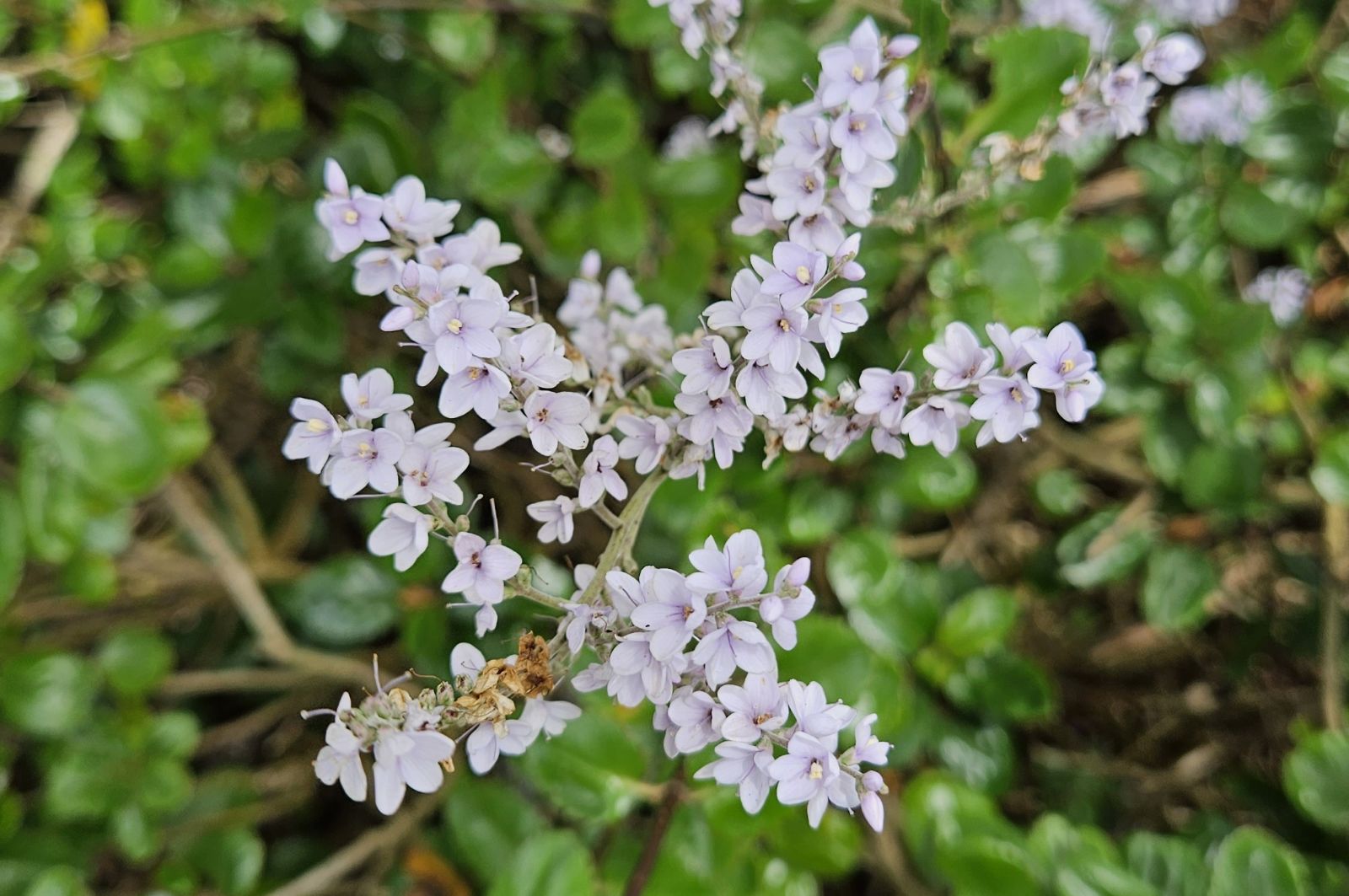Hebe hulkeana
Credits
Article from Bean's Trees and Shrubs Hardy in the British Isles
Recommended citation
'Hebe hulkeana' from the website Trees and Shrubs Online (treesandshrubsonline.
Other taxa in genus
- Hebe amplexicaulis
- Hebe anomala
- Hebe armstrongii
- Hebe brachysiphon
- Hebe buchananii
- Hebe buxifolia
- Hebe canterburiensis
- Hebe carnosula
- Hebe chathamica
- Hebe colensoi
- Hebe cupressoides
- Hebe decumbens
- Hebe dieffenbachii
- Hebe diosmifolia
- Hebe elliptica
- Hebe epacridea
- Hebe × franciscana
- Hebe gibbsii
- Hebe gigantea
- Hebe glaucophylla
- Hebe gracillima
- Hebe hectoris
- Hebe leiophylla
- Hebe ligustrifolia
- Hebe loganioides
- Hebe lycopodioides
- Hebe macrantha
- Hebe macrocarpa
- Hebe matthewsii
- Hebe ochracea
- Hebe parviflora
- Hebe pimeleoides
- Hebe pinguifolia
- Hebe propinqua
- Hebe rakaiensis
- Hebe recurva
- Hebe rigidula
- Hebe salicifolia
- Hebe speciosa
- Hebe stricta
- Hebe tetrasticha
A loose-habited, straggling shrub, occasionally reaching a height of 4 to 6 ft, or even more when grown against a wall – as it usually is in this country. Leaves in pairs somewhat far apart on the branches, broadly ovate, 1 to 2 in. long, 1⁄2 to 11⁄4 in. wide, broadly wedge-shaped or rounded at the base, coarsely toothed, the teeth and apex either blunt or sharp, dark glossy green; stalk 1⁄4 to 1⁄2 in. long. Flowers 1⁄4 to 1⁄3 in. diameter, of a delicate lavender or lilac shade, produced in May and June in huge branching panicles which terminate the shoots. These panicles are sometimes 18 in. long, with side branches 3 to 7 in. long. The flowers themselves arc without stalks, but the ramifications of the panicle are downy. Bot. Mag., t. 5484.
This species, of remarkable beauty and distinction, is a native of the northeastern part of the South Island of New Zealand, where it inhabits dry rocky cliffs and bluffs, often in association with Pachystegia insignis; introduced about 1860. It received a First Class Certificate in 1882 as a plant for the greenhouse, and until recently was reckoned to be a very tender species. But in southern England it survived the testing winters of 1961–3 in some gardens, and at Belhaven House in East Lothian it has lived out-of-doors for forty years and seeds itself into the crumbling mortar of garden walls. Possibly there are two or more strains in cultivation, of differing hardiness (in the wild it ranges from sea-level to 3,000 ft). Or it may be that its reputation for tenderness is partly the result of giving the plants too rich a soil or too cool a position. It is most likely to succeed if planted against a sunny wall, in a well-drained rubbly soil. Plants raised from autumn cuttings will flower well in their second summer, so this lovely species could become a feature of any garden where there is a frost-free greenhouse or frame for overwintering the young plants. It is advisable to remove the panicles as soon as the flowers fade, for these are produced so abundantly that seed-setting may weaken the plant.
H. ‘fairfieldii’.-A shrub of dwarfer, sturdier habit with leaves 1⁄2 to 1 in. long and shorter, broader flower panicles. It first appeared in the Fairfield nursery, near Dunedin, N.Z., and was described by Hooker, and figured, in Bot. Mag., t. 7323. Hooker suggested that it might be a hybrid between H. hulkeana and H. lavaudiana (see below).
H. lavaudiana (Raoul) Ckn. & Allan V. lavaudiana Raoul – This species is closely allied to H. hulkeana, but is a dwarfer shrub with smaller leaves, and with white or mauvish pink flowers in denser and shorter inflorescences (Bot. Mag., t. 7210). Its main home is in the Banks Peninsula, South Island, where it grows in volcanic rock. See further in Journ. R.H.S., Vol. 97, pp. 31, 461–2.
H. raoulii (Hook. f.) Ckn. & Allan V. raoulii Hook. f. – This species, uncommon in cultivation, is allied to H. hulkeana and H. lavaudiana. It is a dwarf shrub with erect or procumbent stems. Leaves smaller and narrower than in its allies, oblong-spathulate, 1⁄4 to 1 in. long, 1⁄8 to 3⁄8 in. wide, long-tapered at the base, with serrated and usually reddish margins. Flowers white or pale lavender, in dense, short panicles (sometimes reduced to a single terminal spike). It is a rock-plant, confined to dry places in Canterbury province. Two varieties are described in Flora of New Zealand, Vol. 1.
From the Supplement (Vol. V)
For an interesting illustrated article on this species and its allies by Graham Hutchins, see The Garden (Journ. R.H.S.), Vol. 109, pp. 58–60 (1984). He has reintroduced this species by means of seeds collected in the north-east corner of South Island, where it grows with two other well-known New Zealand species – Senecio monroi and Pachystegia insignis. Some of the seedlings have proved to be distinct from the form usually seen in gardens here.
H. raoulii – Typically this species is procumbent, but var. pentasepala L. B. Moore makes a small, dense, erect bush and owes its distinguishing epithet to the fact that the calyx is five-lobed against four-lobed in the typical state. The other variety recognised in Flora of New Zealand is var. maccaskillii Allan, which differs from typical H. raoulii in its smaller, obscurely toothed leaves. Introduced by Graham Hutchins.
† H. ‘Hagley Park’ (‘Hagleyensis’). – Like H. ‘Fairfieldii’, described in the main work on page 335, this is a hybrid from within the H. hulkeana group, the seed-parent being H. raoulii and the pollen-parent almost certainly H. hulkeana itself. It makes a rather lax shrub 1 to 13⁄4 ft high, with panicles of rosy purple flowers (see Journ. R.H.S., Vol. 97, fig. 237 (1972)). It was raised by L. B. Brockie at the Botanic Gardens, Hagley Park, Christchurch, New Zealand.



